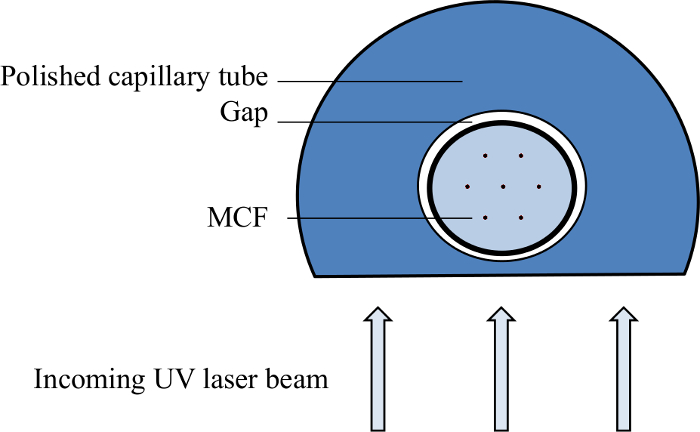写布拉格光栅在多核纤维
Summary
We describe a technique for inscribing identical fiber Bragg gratings into each core of a multicore fiber. This is achieved by introducing an additional surface into the optical path to mitigate lensing by the curved surface of the fiber cladding.
Abstract
Fiber Bragg gratings in multicore fibers can be used as compact and robust filters in astronomical and other research and commercial applications. Strong suppression at a single wavelength requires that all cores have matching transmission profiles. These gratings cannot be inscribed using the same method as for single-core fibers because the curved surface of the cladding acts as a lens, focusing the incoming UV laser beam and causing variations in exposure between cores. Therefore we use an additional optical element to ensure that the beam shape does not change while passing through the cross-section of the multicore fiber. This consists of a glass capillary tube which has been polished flat on one side, which is then placed over the section of the fiber to be inscribed. The laser beam enters the fiber through the flat surface of the capillary tube and hence maintains its original dimensions. This paper demonstrates the improvements in core-to-core uniformity for a 7-core fiber using this method. The technique can be generalized to larger multicore fibers.
Introduction
光纤布拉格光栅(光纤布拉格光栅)被广泛地用作窄带滤波器由于它们可以被定制为大量的应用程序1的事实。它们不限于抑制单一波长;复杂的透射光谱可通过使用非周期性折射率变化2的创建。一个限制是光纤布拉格光栅只能在单模光纤(SMF的)登记的,因为这被抑制对于一个给定的光栅周期的波长依赖于传播常数。在一个多模光纤(MMF),其中每个模式具有不同的传播常数,对于每个模式的抑制波长是不同的,因此光栅不会在任何单一波长给予强烈抑制。
这个实验的动力来自天文学。下视宁受限的条件,直接耦合到SMF是困难的,低效率的;极端自适应光学要求这样做3。正因为如此,磁动势是典型ically从望远镜焦平面4收集光时使用。因此,为了保持只提供给的SMF的功能,有必要具有的SMF和磁动势之间的有效转换。这是可能的光子灯笼,它由通过一个锥形过渡5相连的SMF的阵列的多模端口的装置。光子灯笼在直觉仪器,其中,所述的SMF含有光纤光栅从近红外观测6去除大气发射线(由OH自由基和其它分子)使用。使用单独的,单核的SMF此任务的缺点是它们必须由一个被写入一个,单独地剪接到光学系列,需要显著时间和人工劳动。在这篇文章中描述的技术试图解决使用更复杂的纤维格式,以提供所述单模式功能这些缺点。
下一代OH suppr分裂国家仪器PRAXIS 7将利用多芯光纤(的MCFs)的。这些纤维包含任何数量的嵌入在单包层单moded内核。这种方法的优点在于,MCF可以渐缩到与所得的光子灯笼作为一个紧凑和坚固的自包含单元中的MMF。在已完成的仪器,从望远镜光线会被耦合到灯笼的MMF端口;锥形过渡将该光分离成单模芯在那里将穿过光纤光栅。波长过滤剩余的光被分散到一个检测器之后,光谱收集。
使用同样的MCFs加快写作光栅的过程中,因为所有的内核可以在一个单一的传球内切。然而,写入过程必须按顺序进行修改,以确保所有的核心具有相同的反射特性。这是因为,包层的弯曲表面的光纤光栅,水库的侧写入期间充当透镜ulting中,如果使用标准的侧写入方法在每个芯中功率和方向而变化的紫外场。因此,每个芯将具有不同的传输特性文件,并且在一单一波长8的纤维将不提供强烈抑制。
海军研究实验室的一组修改内核的分布和光敏性取消这种变化9的效果试验。使用这种方法的缺点是光纤必须重新设计,包层尺寸,核心大小,内核和化学成分数量的每个组合。此外,由于缺乏在所得的设计轴对称意味着MCF不能有效地逐渐变细成一个环状铁心的MMF。本文详细介绍了不同的解决问题的方法:有它穿过一个平面上,而不是在曲面包覆直接入射修改纤维内的场。使用这种方法产生一个技术,它可以转移到各种MCF设计和尺寸,尤其是,我们希望将其纳入光子灯笼轴对称纤维。
创造了必要的平坦面,到MCF置于已研磨和抛光在一侧,得到平坦的外壁的UV透明毛细管内部。一个小的间隙,必须在纤维和毛细管之间留下,因为后者可以含有直径±10微米变化。参见图1为一个表示。本文将描述实验过程写在这种方式光纤光栅,并提供可能的改进例子。欲了解更多信息,请参阅先前公布的10模拟和实验结果11。

在FBG产品中使用图1抛光毛细管图离子该MCF放置在毛细管内。两者之间的间隙要小,但允许在直径小的变化。已经通过相位掩模通过紫外光然后进入通过毛细管平面侧系统。 请点击此处查看该图的放大版本。
Protocol
Representative Results
Discussion
图2和图 3一起显示,写入光栅时引入抛光毛细管(PCT)是足以改善MCFBG芯光谱的均匀性。碑文过程的其余部分是从用于创建SMF光栅,可与大多数现有光纤光栅书写系统可以使用已建立的方法基本上没有变化。因此,多氯三联苯准备在协议第2条所列是提高MCFBG均匀性最为关键。最好的结果是用管,其中所述抛光的壁具有一致的,小的厚度实现;这里所选择的50微?…
Divulgazioni
The authors have nothing to disclose.
Acknowledgements
The SAIL labs are funded through JBH’s Australian Laureate Fellowship from the Australian Research Council.
This research was supported by the Australian Research Council Centre of Excellence for Ultrahigh bandwidth Devices for Optical Systems (project number CE110001018).
Experimental work was performed in part at the OptoFab node of the Australian National Fabrication Facility, utilizing NCRIS and NSW state government funding. Fiber hydrogenation services were provided by TE Connectivity in Redfern. SLS would like to acknowledge the Optics and Electronics Laboratory, Fujikura Ltd, Japan for providing the 7-core fiber used in this experiment.
Materials
| Multicore fiber | Fujikura Ltd. | 7 cores with diameter 5.5 µm, core separation 35 µm, hexagonally arranged within 125 µm cladding, NA = 0.177 | |
| Glass tapering machine | Vytran | GPX-3000 | |
| UV laser | Coherent | 300 FreD Innova | Frequency doubled 244 nm, at least 150 mW output. CAUTION: eye damage; wear appropriate goggles |
| Phase mask | Lasiris | PM-244-1069.50-50.8 | Custom component, 1069.50 nm grating period, 5.08 mm thickness |
| Capillary tubes | Polymicro | TSP200794 | Inner diameter 200 µm, outer diameter 794 µm |
| Lapping machine | Logitech | PM5 | Combination grinder/polisher |
| UV-curable glue | Norland | NOA-61 | Cures rapidly, removable with acetone |
| Microgrit | Eminess | Al2O3: 25 µm and 5 µm particle size | |
| Polishing fluid | Eminess | ULTRA-SOL 500S | SF-500S-5, ULTRA-SOL 500S N/D, 5 GAL |
| Sodium hydroxide | 0.004M | ||
| Fiber cleaver | Vytran | LDC-400 | |
| Tunable laser | JDS Uniphase | SWS15101 | |
| IR Camera | Xenics | XEVA-1429 | 320×256 pixel, 16 bit resolution |
| Oven | Thermoline Scientific | LDO-030N | For annealing at T=110°C |
| Hydrogen gas | BOC | For hydrogenating fiber. CAUTION: flammable, pressurised gas | |
| Nitrogen gas | BOC | Booster for hydrogenation. CAUTION: pressurised gas | |
| Acetone | |||
| Razor blades |
Riferimenti
- Othonos, A. Fiber Bragg gratings. Rev. Sci. Instrum. 68 (12), 4309-4341 (1997).
- Bland-Hawthorn, J., Englund, M., Edvell, G. New approach to atmospheric OH suppression using an aperiodic fiber Bragg grating. Opt. Express. 12 (24), 5902-5909 (2004).
- Jovanovic, N., Guyon, O., Martinache, F., Schwab, C., Cvetojevic, N. How to inject light efficiently into single-mode fibers. Proc. SPIE. 9147, 91477P (2014).
- Bland-Hawthorn, J., et al. A complex multi-notch astronomical filter to suppress the bright infrared sky. Nat. Comm. 2, 581 (2011).
- Leon-Saval, S. G., Argyros, A., Bland-Hawthorn, J. Photonic lanterns. Opt. Express. 18 (8), 8430-8439 (2010).
- Trinh, C. Q., et al. GNOSIS: the first instrument to use fiber Bragg gratings for OH suppression. Astron. J. 145 (2), 51 (2013).
- Content, R., et al. PRAXIS: low thermal emission high efficiency OH suppressed fiber spectrograph. Proc. SPIE. 9151, 91514W (2014).
- Birks, T. A., Mangan, B. J., Dìez, A., Cruz, J. L., Murphy, D. F. Photonic lantern’ spectral filters in multi-core fiber. Opt. Express. 20 (13), 13996-14008 (2012).
- Askins, C., et al. Inscription of fiber Bragg gratings in multicore fiber. BGPP. , JWA39 (2007).
- Lindley, E., et al. Core-to-core uniformity improvement in multicore fiber Bragg gratings. Proc. SPIE. 9151, 91515F (2014).
- Lindley, E., et al. Demonstration of uniform multicore fiber Bragg gratings. Opt. Express. 22 (25), 31575-31581 (2014).
- Tomaru, S., Yasu, M., Kawachi, M., Edahiro, T. V. A. D. VAD single-mode fiber with 0.2 dB/km loss. Elec. Lett. 17 (2), 93-93 (1981).

